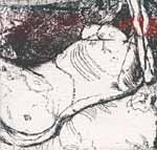|
|
 |
Dusted Reviews
Artist: Herman Düne / Cerberus Shoal Album: The Whys and Hows of Herman Dune and Cerberus Shoal Label: North East Indie Review date: Sep. 3, 2003 |

|
|
|
 |
The Ins and Outs of Whys and Hows
The Whys and Hows… was the first in a series of split CDs by Cerberus Shoal and select contemporary folk artists, a forum for the mysterious avant-folk/jazz/ambient/ethnic-instrumentational group to continue shifting its malleable aesthetic goals into diverse projects. The Herman Düne seem ripe for the picking, considering their own expatriate history – Swiss-born brothers residing in France, released primarily on Southern California lo-fi label Shrimper. Under lovely cover artwork silk-screened by Cerberus Shoal vocalist Colleen Kinsella, words from the two artists spell out the goal of the project (if it can be called that), conceived after meeting twice at music festivals around the world: “to enable the possibility of further meetings, Herman Düne and Cerberus Shoal decided to meet on a compact disc.” We are allowed to eavesdrop on a musical rendezvous.
Herman Düne commences their seven tracks with the grotesquely light-hearted “I Want a Woman”, a charming tip-toe guitar gluing together David-Ivar’s variations on the title’s simple wish. The tone soon sinks rapidly into introverted depression, a sentiment the Düne brothers play all too well. With a sense of loneliness chilling every object in the room, we ache over percussionist Néman’s background shakers and clunks of chain, the incessant itch of violins in the background of “That Woman is a Murderess,” and the grossly overused slide guitar in “Sight for Soul Eyes”. The Düne songs land somewhere between the lands of Maquiladora and the Palace Brothers as the type of delicate, fragile folk recordings where it’s easy to isolate the individual instruments and hear the vocals unconsciously match the guitar patterns.
The moment of crisis occurs in the chorus of “If Someone Loves You”, when the instruments halt and André and David-Ivar croon in unison, “If someone loves me, it’s not you” with a bleakness that would make Jason Molina’s throat catch. With this simplicity they manage to avoid the cliché of emotional self-indulgence that’s common to music about lost love. These odes to solitude are broken up by interludes called “garajes”. The inclusion of these interludes seems unnecessary since the mood is vitally dependent on inward focus, not distraction.
The Cerberus Shoal side (like the opposite face of a record) begins with their own interlude, “Ur”, which surrounds two longer, more fully arranged songs. “Sweetie”, with its chilling, traditional motif (a la John Denver) in the unearthly company of Phil Elvrum’s Mount Eerie choirs, and “Bouzouki”, which rattles those elements inside a Middle-Eastern kaleidoscope, are both lovely complements to the Düne side. The two pieces resemble a ghostly march of singers through the forest, the intimacy of lyrics like “Sweetie, I am coming home” and “Who is in this body of mine?” contorted by the chant of several voices. True to form, their “Ur” interludes are also noisy and cluttered by muted horns and muffled voices, bridging the songs with a frantic exhibition that soothes the posse-in-arms torches and tempers.
Cerberus Shoal cycle the same fixation with introspection and self-loathing as Herman Düne, and never really change the album’s course, unexpected considering its past history as a group that composes “pieces” rather than “songs”. The distinct sounds of each artist blend as two movements, somewhere in between a true “split” album and a collaborative effort like Macha Loved Bedhead. In the end, Cerberus Shoal and Herman Düne’s wild, imaginative meeting confounds typical collaborative expectations. This work – and the series that follows – demands attention as a conceptually innovative public space where uncommon sounds dispense of difference and share the spotlight.
By Joel Calahan
|







